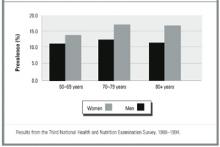Each interview was conducted in the participant’s home. In addition, a detailed clinical examination was conducted in a mobile examination center. For the purposes of this investigation, we examined the data from the 6596 adults 60 years and older. The interviewing staff consisted of experienced persons, many of Hispanic origin or fluent in both English and Spanish. All staff members attended annual training sessions to ensure maintenance of effective interviewing skills.
Information on self-reported race and ethnicity was used to classify persons as non-Hispanic white, non-Hispanic blacks, or Mexican American (persons of Mexican origin living in the United States). Age was defined as the age, in years, at the time of the household interview, which preceded the medical examination by 2 to 3 weeks.
Hip pain
Participating adults 60 years and older were asked to report “whether they had experienced significant hip pain on most days over the preceding 6 weeks.”
Physical activity assessment
Trained interviewers used a questionnaire to obtain information on leisure time physical activity (LTPA) during the previous month. The questionnaire was adapted from the 1985 National Health Interview Survey (NHIS), which was used to establish baseline estimates for several Healthy People 2000 physical activity objectives. Participants were asked to specify the frequency of participation in LTPA during the previous month for the following activities: jogging or running, riding a bicycle outdoors or an indoor stationary bicycle, swimming, aerobic dancing, other dancing, calisthenics or floor exercises, gardening or yard work, and weight lifting. Four open-ended questions assessed information on physical activities not previously listed. Participants who responded negatively to all LTPA questions, including the 4 open-ended questions, were classified as persons who participate in no LTPA.
Statistical analysis
Statistical analyses were carried out using the SAS7 and WesVar PC8 software packages. For each survey, sampling weights were calculated that took into account the unequal selection probabilities resulting from the cluster design and from planned oversampling of certain subgroups. All analyses have incorporated sampling weights.
Results
Overall, 14.3% (95% CI, 13.1-15.5) of older US adults reported significant hip pain on most days over the previous 6 weeks. The age-specific and sex-specific prevalence estimates of US adults reporting severe hip pain on most days are shown in Figure 1 Men reported hip pain less frequently (11.9.1%; 95% CI, 10.2-13.7) than women (16.2%; 95% CI, 14.5-17.8). Reports of hip pain are similar in men aged 60 to 70 years, 70 to 80 years, or older than 80 years. The lowest prevalence of hip pain was reported by women aged 60 to 70 years.
The race-specific prevalence of severe hip pain on most days during the previous 6 weeks is shown in Figure 2. Among non-Hispanic white adults aged 60 years and older, 12.4% of men (95% CI, 10.2-14.1) and 16.0% of women (95% CI, 14.0-17.9) reported hip pain. In contrast, 14.8% (95% CI, 11.7-17.9) of non-Hispanic black women reported hip pain, as did 19.3% (95% CI, 14.9-23.7) of Mexican American women. Reports of hip pain among non-Hispanic black men and Mexican American men were similar to those of their non-Hispanic white male counterparts.
Among adults aged 60 years or older, 18.4% (95% CI, 16.5-20.7) of those who participated in no leisure time physical activity reported severe hip pain, while 12.6% (95% CI, 11.7-14.1) of those who did participate in some activity reported such pain.
FIGURE 1
PREVALENCE OF SIGNIFICANT HIP PAIN ON MOST DAYS IN OLDER ADULTS, STRATIFIED BY AGE AND SEX
FIGURE 2
PREVALENCE OF SIGNIFICANT HIP PAIN ON MOST DAYS IN OLDER ADULTS, STRATIFIED BY RACE AND SEX
Discussion
This study offers a current report of the prevalence estimates of significant hip pain among US adults aged 60 years or older. We found that hip pain affects a higher number of older Americans than would be expected from previous studies. For instance, data from NHANES I demonstrated that from 1971 through 1975, 0.7% of patients reported hip pain secondary to OA.1 NHANES I, however, did not include any subjects older than 74 years. Our study found that 14.3% of US adults aged 60 years or older report hip pain on most days of previous 6 weeks, but we cannot yet determine the etiology of this pain.
There are 2 possible explanations of this apparent increase in hip pain between the time of NHANES I and that of NHANES III. First, the source of most hip pain in the elderly may be nonarticular in nature. Once radiographic data become available for NHANES III, this possibility can be further analyzed. A second explanation may be that the incidence of hip OA is increasing over time. This explanation is plausible, considering both the aging of the population in the United States and the increasing rates of obesity and sedentary lifestyle. Here, too, radiographic data will be useful.



